
The Impact of Technology on Advertising and Social Media
By: Tree Fitty
April 23, 2023 5:23 AM / 3 Comments Marketing Influencer Education ZentaPost
Social media evolved from technology and advertising to allow user-generated content to become a valued tool of digital marketing strategists. As television and newspapers lost attention to search engine traffic and social media communication, advertising evolved with technology to place itself between people trying to communicate. This marks the evolution from advertising placement between people and the information they value to mass amounts of people placing advertising between themselves and the people around them. The Impact of Technology on Advertising and Social Media goes over the history of technology and advertising then transitions to the current state of digital advertising and social media.
You can also watch Recorded Readings video version of this blog on Zentagram or YouTube.
How Advertising Changed with Technology
The history of advertising dates back to Ancient Egypt but advertising turned a new page when the printing press was revolutionized in 1440. This updated printing press allowed printed work to be mass produced. In London in the 1700’s, ads were 24-75% of the content in newspapers. It is interesting Benjamin Franklin started in printing and ended up on the one hundred dollar bill (USD).
Advertising in the 1800’s brought two major changes, art and technology. The nineteenth century brought gas, oil, and electricity, but the real locomotion of change was the railroad. After the Bessemer process allowed for mass steel production, steel allowed for the railroad to become the internet of its time. The railroad supplied transportation of people, products, and information. If the railroad was the internet, I guess that makes “Trade Card” advertising the NFTs. These trade cards, sampled below, were collected by people and kept in scrapbooks. The idea was to prolong the life of the advertisement.

While the sense of needs and desires were present in artistic advertising, sample pictured above, there was also still a good amount of information-focused advertising. To see another form of advertising take a look at the Emergence of Advertising in America: 1850-1920 from Duke University.
There is a slider to set time ranges. Try setting different ten year periods and also take note of the difference in the media of the American South and North.
The rise of mass consumerism as a product of the second industrial revolution allowed for a new media, magazines and catalogs. Ads began to be placed inside of articles and product names were used in the articles themselves.
Women were thought to make 80% of household purchases and advertisings sought to convince women they would be happier if they used the advertised products. Food, clothing, beauty products, and later home appliances, were illustrated as necessities of a proper wife or even as key ingredients to getting married.
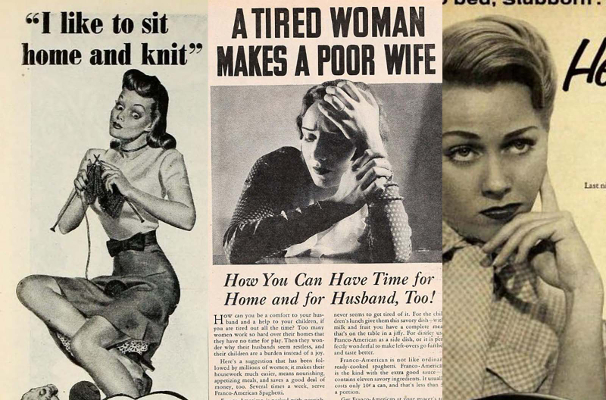
The above magazine images have some stark contrasts to the Trade Cards and info-ads of the previous time period. If the railroad was an early internet and trade cards were NFT’s, possibly early magazines could be viewed as an early version of social media. Magazines even had influencers:
For instance, Antoinette Donnelly, who wrote a syndicated newspaper column called "Beauty Hints," sold her name to a manufacturer of facial soap, who capitalized on her "brand identity." The trade press applauded this marketing move, noting that consumers "have acquired a confidence in her judgment through years of familiarity with her writings."[5]
From the magazine era were born radio ads. Radio ads led to television ads. Control of the radio was instrumental in coercing the citizens of Germany leading into World War II but another example of the power of the radio is Orson Welle’s “War of the Worlds” radio broadcast. This 1938 radio broadcast of HG Wells’ book convinced people an alien invasion was happening. The result was mass panic. Possibly, Welle’s broadcast foreshadowed what was to come for the news industry.
Note: The Great Moon Hoax of 1835 was a newspaper version of what happened with Welle’s War of the World broadcast. The fictitious Great Moon article convinced people there were aliens on the moon.
Media shock and awe ran rampant in the 1990’s with the rise of dramatized news, tabloid TV, and reality TV shows. In the midst of this, The Media Decade and the internet gave birth to search engines. Email lists and blogging entered the scene as new ways to not only express oneself, but as new methods to market a brand. These were the predecessors of social media.
In 2000, Google, which had evolved from a Backrub, had made its stand as the most used search engine on the internet.
Google’s Difference
The earliest search engines focused on developing business models that monetized search. For example, up until the last decade or so, Yahoo, organized its paid search service, Overture, by who paid the most. When advertisers can buy their way to a top spot, it often comes at the cost of user experience, and that’s where Google did things differently.
Google’s entire business model focused on providing a better user experience. Its algorithm accounted for multiple factors, such as page quality, number of links and relevance to a user’s search in addition to how much advertisers pay, thus improving Yahoo’s original model. Because Google provided the best product, everyone wanted to use it.
Source: Forbes
“Because Google provided the best product, everyone wanted to use it.”
LinkedIn, Myspace, and Facebook launched in 2002, 2003, and 2004. While Google was the best at connecting people to information, Facebook became the best at connecting people to people.
On November 6, 2007, Facebook unveiled Facebook Ads. Technology had taken advertising from magazines, to radio, to television, to internet. As technology changed, the way people looked for information changed with it. Advertising was always there to not only benefit from, but contribute financially to the distribution of information. Because of technology, Facebook, and later many other social media platforms, allowed advertising to be placed between people and the people they were trying to connect with. From there, on a scale like never before, technology allowed people to become the advertising.
The Data on Paid Ads and Influencer Marketing
Social media advertising accounts for 33% of all digital advertising. The United States is the biggest spender when it comes to social media marketing and will be used as an example of how money is being spent on digital advertising.
Below is social media ad spending in the United States from 2017-2027. In 2022, social media ad spending, according to Oberlo’s Social Media Ad Spend in the US report, was $80.67 billion.
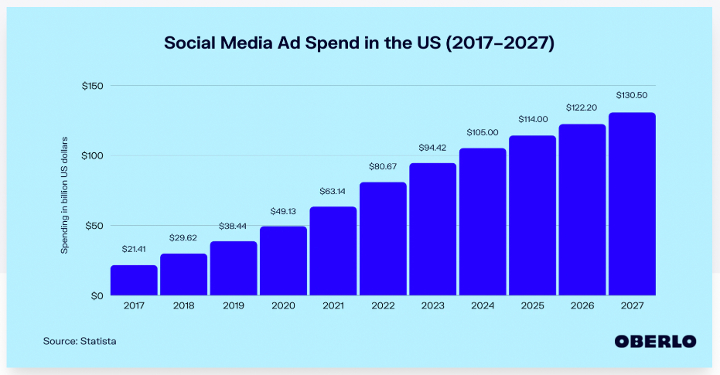
Mostly for comparison, Google Ad Revenue in 2022 was $70.15 billion. Google ad revenue, like social media paid ad revenue, is projected to grow less over the next two years. Oberlo Report
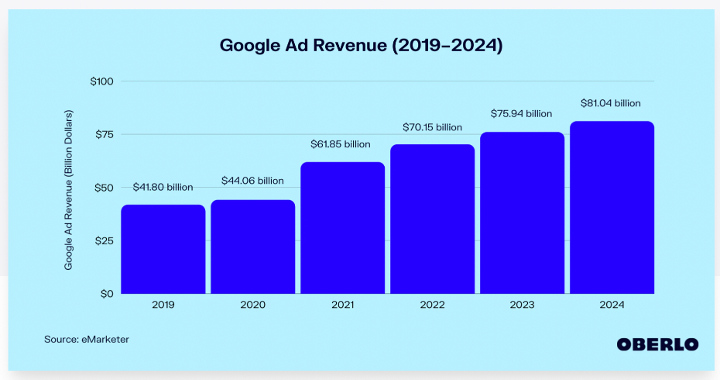
Now let’s look at Influencer Marketing Spending between 2019-2024 according to Oberlo. US Influencer marketing spending was $4.99 billion in 2022.
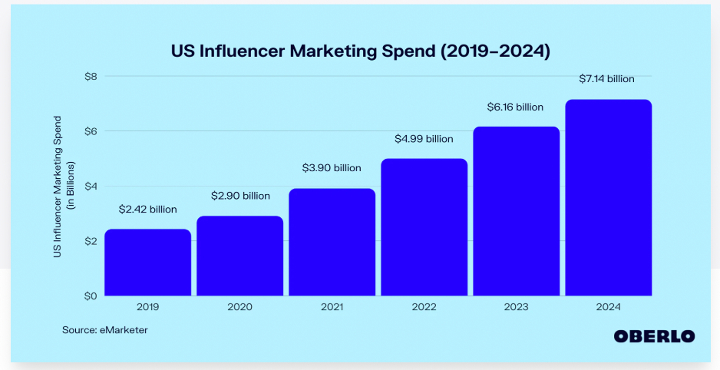
This data is not made to appear scientific. The purpose of the data is to show a potential opportunity a social media company may see when their own revenue is decreasing. However, other sources produce mostly similar numbers. Without actually comparing them side by side, it seemed influencer revenue could be outpacing social media companies faster than showed by the data above.
Accepting the charts and data as true enough, it is clear social media ad spending gets the most ad revenue. Social media advertising is several times more than influencer marketing and often more than Google and Influencer marketing added together. Let’s look at the percentage of increase for each year and each type of advertising.
| Growth%/yr | 2019-2020 | 2020-2021 | 2021-2022 | 2022-2023 | 2023-2024 | |----|----|----|----|----|----| | Social Media | 27.8% | 28.5% | 28.1% | 16.8% | 11.2% | | Influencer | 19.8% | 34.4% | 27.9% | 23.4% | 15.9% | | Google | 5.4% | 40.4% | 13.5% | 8.3% | 6.7% |
Now, projections are projections but who looks at projections? Well, Oberlo, the dropshipping arm of Shopify cared enough to collect and visualize these projections. The biggest companies in the world look at projections. Google and many social media companies have their own data analytics. This can even include conversions and ad tracking. Now, if revenue models are based off paid advertising, this would make Google, social media, and influencers, in some ways, competitors.
Pinned between Google and their own users, a social media company may find their own independently monetized users to be competition to the platform’s ad revenue. Would you pay a platform directly when an influencer can bring more sales or a better ROI?
While some influencers could be niched on a certain platform, some could be on many. The influencers on many platforms may have a website or following that leaves one platform to see the influencer’s content on a different platform. This most likely causes a loss to the original platform’s ad revenue and possibly a gain for the influencer, Google, or even the other social media platform.
It is not unjust for a company to protect its financial stability from its competition. However, in terms of advertising money as revenue, the people using a social media platform can also be the competition of the platform they are using.
Social media companies as a group are bringing in tens of billions of dollars each year, why would enormous companies be worried about influencers earning a piece of digital advertising money?
The Rise of the Content Creator Economy
Advertising was part of the digital experience since the early days of public internet. Advertising has always been part of new media. Social media was no exception. But what technology allowed was for more individuals to take their own roles and revenues from paid digital advertising. This transition changed the dynamics of paid advertising, social media, and content creators.
Businesses, Social Media, and Users
Early social media was a new way for people to connect like never before. It also presented new ways to advertise. The social media advertising model was simple in the beginning. Businesses would create advertising content and pay social media platforms to show their ads to people. The users were treated as consumers and potential buyers.
However, at this time, as described in the success of Google, the best user experience would bring the most users. In the early days of social media, it was required to focus on the users or the structure of the entire social media platform would fail. On old social media, users were not necessarily customers.
Businesses, Social Media, Content Creators, and Users
The social system of social media blended who was a producer and who was a consumer by giving everyone the ability to be a content creator. Businesses started accounts to become more relatable to people. People created content in ways that made them producers and advertisers. Technology allowed society to blur the lines of digital business interactions and digital personal interactions.
On YouTube, Facebook, and other platforms, users of social media platforms began creating content that gained more attention than paid social media marketing. These were the early stages of influencer marketing. But businesses themselves also became content creators.
An early example of big business taking to social media themselves is Coca Cola’s #ShareACoke.) campaign. People wanted a can or bottle of Coke with their name on it and Coca-Cola, through social media and technology, allowed people to create a custom bottle of Coke with their name it.
The relationships blurred even more because Twitter created a custom Coca-Cola emoji. People Tweeted about Coke. A business, a social media platform, and users, all created Coca-Cola content together.
The image below is from Coca-Cola’s #ShareaCoke: Social Media Marketing Campaign Analysis.)
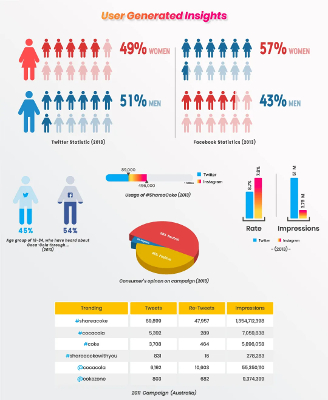
Also worth noting is that Coca-Cola started it’s campaign in Australia. It harnessed an Australian community to power its global social media campaign that offered a collector feel to consumers. Looking back at the “Trader Cards” of the nineteenth century, Coke not only increased the profitability of advertising but they created a sense of collecting Coke products that people had a personal attachment to. These characteristics of Coca-Cola’s #ShareACoke campaign would later be used in many Web 3.0 marketing strategies.
Businesses, Social Media, Influencers, Content Creators, and Users
Similar to Antoinette Donnelly and her column “Beauty Hints” that was referenced earlier in this report, social media allowed creators to blend personal and professional branding. Pictured below, the term “brand ambassador” became used more and more at the same time Coca-Cola was pushing their #ShareACoke campaign. Brand ambassador searches on Google peaked around November 2019. Since then, money spent on influencer marketing has only increased.

As the term “brand ambassador” plateaued in usage, the term “influencer” drastically increased in usage.
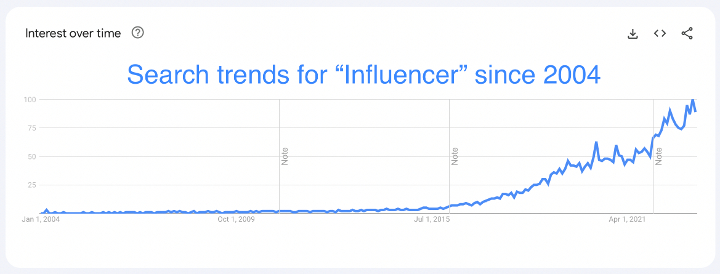
This data supplements the earlier data that money spent on influencer marketing is outpacing the increase of money spent on paid ads on social media and Google. As brand ambassadors and influencers made their rise, searches for “meet people online” began to decline. These insights on what people were searching for online represent the focus of attention that took place on social media platforms.
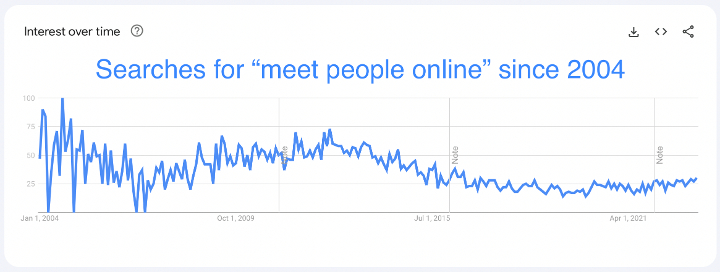
Social media started as a way for people to express themselves, a way for people to connect, a way for businesses to advertise, and a way for social media companies to capitalize on their users by selling their attention to interested parties. Over time, both businesses and individuals found that they themselves could use social media to assert their own influence.
Brands created content themselves as influencers also collected more and more revenue that otherwise would have probably gone to social media platforms. The effect of this was that content creation for the purpose of advertising became manufactured and shared as a science of influence and profit.
To go a step further, influencer revenue and online branding is not a realized utopia of taking revenue otherwise going to large companies. Referenced from The Creator Economy Needs a Middle Class in 2020, only 2% of Patreon creators made federal minimum wage and 1.4% of Spotify creators collected 90% of the royalties. These numbers seem to have improved with rising interest in micro-influencers and nano-influencers leading into 2023.
The culmination of decreasing profits, users as disadvantaged businesses, and decreased satisfaction of social media users who consume content but not products, led to the dispersion of social media attention not only across existing social media platforms, but to new platforms all together.
Social Media Competition: Old Social Media and New Social Media
Social media companies are not only in competition with their own users, they are in competition with each other. Since the rise of influencers and the change of focus to video content, social media usage and advertising have changed focus as well. Below is a chart from Pew Research that shows which social media platforms are most popular over time in the United States.
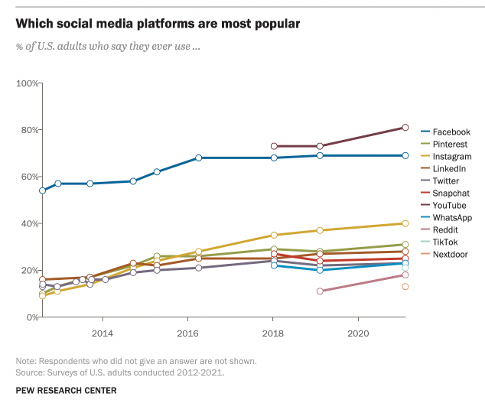
However, if we look at the usage of social media platforms by US teens we see the focus being shifted towards social media platforms that focus on video content. In particular, short form video content.
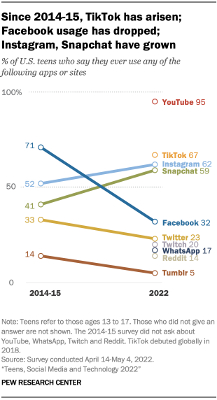
This newly found focus on social media video content did not go unnoticed by advertisers. US social networking video ad spending continues to increase in total while percentage of revenue to platforms is barely increasing.
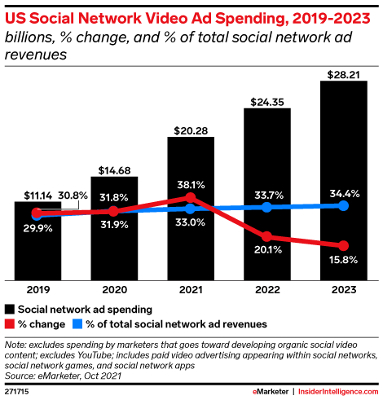
The results of increased video advertising and the focus of the new generation on video content is mirrored by a shift in spending associated with which social media a person uses. Below is the average revenue per user (ARPU) as supplied by PostBeyond. This important metric supplies an outcome that warrants also worth noting that a market dominated by US spending is being captured by a company based out of China.
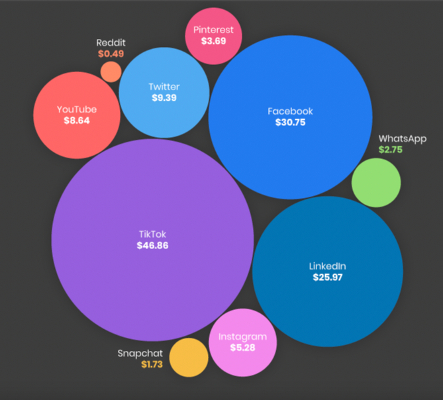
Ownership and misuse of data also exacerbated social media migrations. Data sold for advertising purposes, and other things, contributed to more and more people migrating to other platforms. People also became dissatisfied with dramatized news, fake news, and censored news as manipulation. These reasons, in combination of Web3 technology creating new ways to own and monetize a brand and identity online, led to a rise in decentralized social media platforms.
More information about decentralized social media can be found in the CoinTelegraph documentation titled What are decentralized social networks? That is also the source of the list of decentralized social networks below:
- Diaspora is one of the oldest decentralized social media networks, launched in 2010. It was touted as a prominent Facebook alternative.
- Built on top of the well-liked decentralized social media protocol Nostr, Damus is a well-known decentralized social media platform with an easy-to-navigate user interface.
- Mastodon is a decentralized microblogging platform that allows users to create and share short text posts and follow other users. Mastodon boasts of being the world’s largest free, open-source, decentralized microblogging network. Basically, Mastodon is an open-source alternative to Twitter.
- Peepeth is an Ethereum-based social network alternative to Twitter that aims to provide a more secure, private and censorship-resistant platform for social media.
- Hive is a decentralized social network built on the blockchain and aims to provide a more secure and transparent social media experience.
- Minds is a decentralized social network that aims to provide a more open and transparent platform for free speech and digital rights. It allows users to speak freely, protect their privacy, earn crypto rewards and regain control of their social media.
- Pixelfield is a decentralized alternative to Instagram launched in 2018. It offers users control over their data and ensures the privacy of users’ images without any advertisements on the platform.
- Status is a secure messaging DApp that uses an open-source, peer-to-peer protocol and end-to-end encryption to protect users’ messages from third parties.
- Mirror is a decentralized, user-owned publishing platform built on Ethereum for users to crowdfund ideas, monetize content and build high-value communities.
- Lens Protocol is a decentralized social graph launched by the team behind Aave (AAVE) in 2022. It helps creators take ownership of their content. The project gives users the tools to create their own social media platforms using Web3 technology.
- Steemit is a blockchain-based blogging and social media website founded in 2014. It was specifically developed using steem blockchain technology.
- DTube is a blockchain-based social media video network. It was built on Steem and the IPFS, with users paid in the Steem (STEEM) token. Subsequently, it switched to its Avalon blockchain.
- Only1 is an NFT-powered social media protocol built on Solana.
- Aether is an open-source platform for self-governing communities with auditable moderation and moderators elections that is an alternative to Reddit.
Note: Use extreme discretion and discernment before connecting your crypto wallet to anything. If you are new to Web3, I highly suggest taking time to educate yourself before interacting with wallets or purchasing crypto currencies. Find a community you feel safe with.
The length of that list alone is enough to cause confusion and dispersement of attention and focus. The fact that each of those networks has or had a group of people join shows, even at a minimum correlation, the migration of people and attention to new social media platforms. The migration to decentralized social networks is a layer of user dispersement that sits on top of the already changing Web2 social networks conundrum. With migrations of users comes changes to advertising schemes.
In addition to people finding new social media, some people are quitting social media all together. The six reasons people are leaving social media align with the reasons people are finding new social media:
- Politics and propaganda
- Insecurity and jealousy
- Privacy and security
- Unrealistic expectations
- Waste of time
- Social media’s not really social anymore
To add to the changes in sentiment, many social media companies are creating subscription models and changing algorithms to benefit paying customers. This move not only goes against the user focused model that made Google great, but it causes cultural conflict within social media on several levels. Some brands cannot afford the subscriptions and will be drowned out by those that can. Some people have a hard time keeping up with their friends because they are force fed content from those that are paying or fit the benefits of the algorithms. But ultimately, this new revenue model may be what pushes the non-paying social media users right off the platform. If this happens, it decreases the value of not only social media ads, but influencers as well.
Social media platforms have been confronted with a swath of changing priorities of users, a user base that threatens the revenue of social media companies themselves, all while there are more social networks than ever before.
Did advertising break social media?
The history of advertising used information delivery as the medium to which it delivered its messages. Changes in technology brought changes in communication. New ways to communicate became new ways to advertise. The internet, computers, and code blended humans and the digital advertising medium. Technology allowed people to connect so much with each other that the people became the advertising. That created the situation surrounding social media, influencers, and users.
Noted by the change of terminology in Web2 social media to the usage of Web3 social networks, the interest of the people who care about networking, or connecting with other people, have seemingly detached themselves from the networks that have been consumed by consumerism. Ironically, the networks that have broken from advertising-dominated social structures, have, in some situations, when connected to blockchain, attached a monetary cost and potential reward to every piece of content they share on their new network.
Worth noting, the tactics of turning customers into communities through collectible advertising and social marketing have been embraced by the new technology stack provided through Web3 and NFTs. While possibly a transitionary one, the product of social monetization and decentralized social networks seems to have contributed to the dispersal of people and connections across many platforms, resulting in limited ability to find meaningful interactions.
The financial benefits of advertising for social media companies have contributed to the decline of interest of every day users and placed a barrier to entry for users as brands to find financial benefits of social media use. Social media algorithms promote self-beneficial content. Self-beneficial in this case is not focused on quality and user friendliness, but driven by engagement and advertising revenue.
Influencers are the new marketing force and are often required to play by the rules of the platform to be successful. Many influencers reinforce the self-perpetual social media algorithms. Revenue focused operations reinforced revenue focused platforms and algorithms.
Again, referencing Forbe’s comment about Google, “When advertisers can buy their way to a top spot, it often comes at the cost of user experience, and that’s where Google did things differently… Because Google provided the best product, everyone wanted to use it.”
Google’s advertising model has been dethroned by social media ad revenue as a whole. The social media ad revenue model is threatened by influencers and Web2 social media exodus. The result of prioritizing advertising revenue in changing technology seems to have scattered people to so many different corners of the internet that the very purposes of a network, connecting and communicating, are at risk.
A Google search of “top social media influencers” goes to a HootSuite Blog that references the Ourplace Instagram post featuring Selena Gomez with 51,000+ likes. This image represents the power of influencer marketing as provided through the technology of social media.

Comparing this image to the first image in this report “Clean with Lavine,” it seems technology has brought little change to the imagery of advertising. However, technology, as illustrated throughout The Impact of Technology on Advertising and Social Media, has allowed advertising a deeper and more frequent exposure to the reinforcement of consumer culture that was seeded long ago.
Possibly, technology enforced advertising so intensely, that actors have stolen the stage from the theater. Possibly, it was advertising that stole the stage from technology. Possibly, like the theaters in real life, technology and advertising have destroyed the social and entertainment value of social media. At least for now.
Note from the Author:
I started my higher education in Business but switched to History. My fascination was and is in Sociology. Later in life, as a means to develop my own businesses, I dove deeper into technology and learned fullstack web development. This platform, Zentaurios, was developed by me as an attempt to turn media and advertising of all forms to mediums of self-expression, facts, and information. I would love to a see a human connection made through media that is absent of outside monetary influence.
If you made it this far, thank you for reading.
This report probably took 30-40 hours to gather information and write. It is the first piece I thought about putting behind a paywall. I chose not too because I feel the information is too powerful not to share.
If you are inclined to support my writing and efforts, a wallet address for me is 0x3f099c2522777D276e68092DDfEE317f6611B381
CashApp: $TreeFittyWebDev
If you wish to join myself and others on this journey, feel free to Signup to Zentaurios
Another way to support and join the effort is by purchasing a Zentaurios Legacy NFT.
Also, if you are looking for writers or other media content involving Web3, AI, or anything, feel free to email [email protected]
Thank you everyone for giving me over 4,000 words of your time!
\
